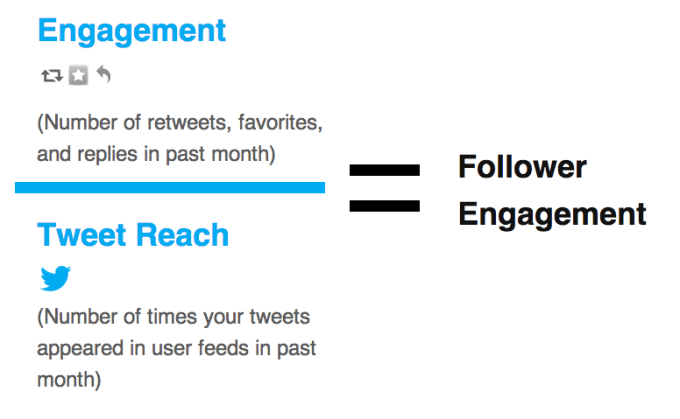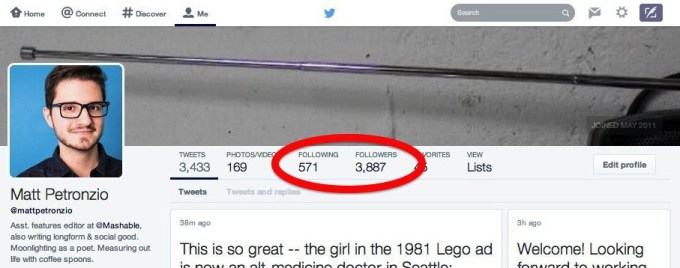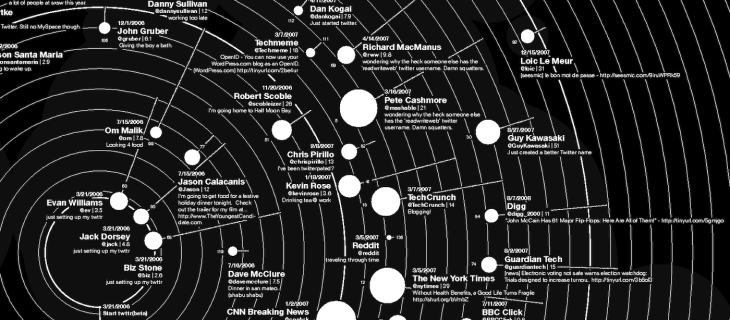For the past three years this post has been stuck in the drafts folder of my computer. I didn’t finish because I would go to edit it then convince myself, halfway through, that I was on the verge of a way to fix Twitter and my time was better spent coding.
I’ve stopped thinking that there is a solution for Twitter. There is, instead, a systemic problem that all digital platforms face but few have ever dared to tackle.
The most significant problem with Twitter is that it’s hard to get followers if you’re a new user.
This seems like a small problem at first, but it’s a core one that extends to every corner of the product. The problem is so big because it builds on itself.
Twitter operates as an unregulated market for social capital.
The reason joining Twitter was so exciting in 2007 is the same for which it was exciting to register a domain name and start an Internet business in the 1990s — the first people who show up to open markets can win big. Yes, you can get a good username, but the real issue is the network effects that come from being first. It’s a classic platform problem.
Every time you’re followed it gets easier for others to follow you because you have a bigger audience more likely to spread your message to more people.
It’s easy to make an argument that what happened to blogging, and what is happening to Twitter, is a network effect and destined to happen to any platform, but that’s the easy and cynical way out.
You can design a social media platform that is more fair to new users just as you can design a government that is more fair to its less privileged citizens.
If you want a platform to thrive you need to do what good governments do: help newcomers, break up monopolies, and keep it competitive.
How To Make Twitter More Fair And Competitive
The story of my experience on Twitter is the story that is celebrated — but rarely the case for most people. When I joined Twitter in 2009 it was like showing up to a half-settled frontier town. I could talk with people who would normally never talk to me, I could gain a following in fields where I was years younger than most, and I could do this all from a laptop in my underwear.
Twitter was magical in 2009 because the platform was getting a daily flood of users of all stripes eager to find accounts to follow. We’ll never be able to get back to that era of Twitter, but there are a ton of things Twitter can do to help users.
Reward Engagement Over Inheritance
Twitter has a built-in method to reward users and it’s called the Suggested User List. The list comes in many flavors. You get a list curated by Twitter’s editorial team when you first join. This list is full of celebrities and recognizable news sources — in 2009, Anil Dash wrote a good post about what it’s like to be on this list. You then get a mix of personalized suggestions when you follow someone new in your email and in the left column after you follow someone. The algorithm for this is hidden but I get the same suggested users over and over, and I’m willing to bet most of these suggestions are fueled by overlapping followers of the people I follow.
The Suggested User List is a mechanism that can make Twitter more competitive but only if it rewards a behavior new users have a shot at. Imagine if it the list were generated more like this:
- Twitter builds a long list of potential followers based off the people who you are already following.
- Twitter orders that list based on their recent follower engagement.

The key point here is to give rewards to the people who make the most of the followers they already have.
In this case, a new Twitter user who is followed by a handful of people has a shot at getting promoted if their tweets are resonating. And then on the flip-side, if that user gains a ton of followers, they have to maintain their level of engagement or they fall off the list.
This algorithm is obviously just a sketch — there are a zillion other factors to consider — but the point is to reward a behavior that both new and old users can achieve.
Active Followers > Legacy Followers
One of the worst behaviors I will admit to doing on a regular basis is to rapidly judge a Twitter user based on the number of followers they have. I know it’s wrong and stupid, but this is the metric that Twitter gives you on a profile to assess legitimacy. It’s hard to look away. Twitter’s latest profile redesign maintains this focus.

The follower/following metric is such a toxic way to determine legitimacy because it doesn’t indicate whether this person’s tweets are being viewed by anyone.
Those who have been on Twitter a few years can game this by accumulating a large percentage of followers who never return.
A simple thing Twitter can do to make this metric more fair is to change number of followers to active followers. Active followers would mean something like number of followers who have logged in the past 30 days. Additionally you can have a metric like Tweet Reach, which would be the number of times a tweet from this user loaded into the timeline of another in the past 30 days.
It’s easy to see why this is a scary proposition for Twitter. Switching to active followers means breaking the news to users that they’re considerably less popular than they’ve been told. This is hard for platforms to do, as it would be a judgment day for a lot of precious egos. The consideration is that power on Twitter is displayed in a way that is more realistic and encouraging to newcomers.

What It Means To Start At 0
It’s hard for many who gained prominence in the first wave of Twitter to empathize with what it’s like to join Twitter today. To the first wave of users, Twitter is a bilateral marketplace of ideas. A meritocracy. You get people you admire to follow you through your own tenacity and wit. It was a frontier town where you made up the rules.
Twitter does not look like a frontier town today, it looks like Game of Thrones.
Every vertical, whether it’s tech, liberal politics, or the NFL, has a maze of gatekeepers firmly entrenched in their own respective fields. People beg for retweets. Companies pay bot armies to follow them. Those with power sell their tweets to the highest bidder. The prospect of starting from zero is daunting to the point that many just opt out.
Twitter’s Establishment Class
Open systems start with no hierarchy, so they look like meritocracies at first, but network effects mean newcomers create a hierarchy, often without even meaning to. We will never return to a Twitter where there’s little difference between newcomers and the old guard. The important questions to ask now are the same questions that were asked in an era of media where there were printing presses and delivery trucks.
How can you keep things competitive? How can you help newcomers? How can the status quo be challenged and unseated?
When you direct these questions to the owners of a platform, they don’t know how to respond and that’s partly because they don’t feel they have to. They’re tech. They make the pipes. If Twitter wants to survive, this is an attitude that will need to change.
Twitter’s product has not changed significantly since it was first sketched on a notepad. In some sense, this is admirable, but there comes a time when doing the same thing lends itself to an entirely different outcome. That is what is happening now and Twitter is hurting. Twitter’s stock is sinking. Their user growth is flatlining. Facebook is making aggressive moves in the public news space.
I love Twitter. I’ve met some of my favorite people and friends through the site. But I also recognize that my success on Twitter is a privilege tied to the date I claimed my username. If Twitter wants to survive, they’ll need to keep this privilege in check. A new generation of Twitter users ultimately wants what the old generation was able to get—a fair shot at being heard. Getting there again means Twitter will need to change the way it rewards users and measures success.
The only way that you’ll get Twitter to act is if they see this as a problem then feel the pressure. Now’s a good time to Tweet. Send one to: @dickc, @ev, @jack, and @biz.
Editor’s note: Cody Brown is the co-founder of scroll kit. Before scroll kit he launched kommons and nerd collider, products to make conversation on the web smarter and more inclusive. Follow him on Twitter.
